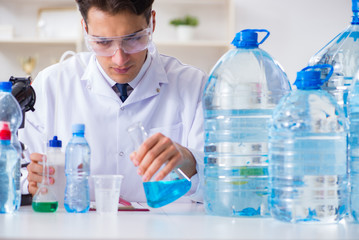Performing Water Quality Testing Near Me is important for many reasons. It helps to determine whether or not your water is safe to drink and can be used to monitor water treatment processes. It can also be used to detect contamination. Getting the right kind of solids for good water quality is important. Total solids in water samples can affect water clarity and aquatic organisms’ health.

Total solids in water samples can come from a number of sources. Some examples include agricultural runoff, residential runoff, and discharges from sewage treatment plants. Total solids can also come from natural sources, such as rivers, lakes, and springs. Industrial wastes also produce them.
Total solids in water samples are measured using a number of common laboratory procedures. The methods are relatively easy to perform and inexpensive. The results are generally used for aesthetic purposes but are also used as an aggregate indicator of a number of chemical contaminants. A high level of total solids can cause a number of negative effects. Some examples include increased flooding risk, decreased passage of light through water, and reduced efficiency of wastewater treatment plants.
Generally, total coliforms in water are not harmful. They are present naturally in soil, plants, and animal waste. However, if your water is contaminated, they may be an indicator of a disease-causing microorganism.
Water systems have to monitor for total coliforms. They can then determine whether or not the system is vulnerable to contamination and whether or not they need to do something about it.
There are several different methods used to test for coliforms in water. They include a Most Probable-Number (MPN), the presence/absence method and the ColitagTM method.
The Most-Probable-Number method is a statistically-based method that estimates the number of bacteria in a sample. It can be less expensive than the presence/absence method. The presence/absence method uses color changes in test tubes to determine whether or not a certain pathogen is present.
Coli is an indicator organism of fecal contamination of water supplies. Its presence indicates a possible pathway to wells, either through the sewage system or faulty septic tanks. It may also indicate the presence of other contaminants. Contact your local water quality district or health department if you think your water is contaminated.
The bacterium E.coli can be present in lakes, streams, rivers, and other sources. It is usually present in human waste and animal feces. It is not generally dangerous to human health but can cause infections, such as diarrhea, fever, vomiting, and stomach cramps. It can also be transmitted through swimming in contaminated water. It is a good idea to discontinue use of water that has been contaminated with E.coli.
There are many strains of E.coli, but most strains are harmless to humans. A few strains may cause disease. It is a good idea to get a sample of your water and have it tested by your local health department.
Various types of indicators are used to detect contamination in water. Some indicators of contamination in water are pathogens, chemical pollutants, minerals, and turbidity. These are important factors in determining the quality of water.
Escherichia coli is one of the most important indicators of contamination in water. These bacteria are found naturally in the feces of warm-blooded animals. They are considered the best indicator of fecal pollution. Water contamination indicators are also tested for the presence of harmful chemicals such as arsenic and mercury.
Other water contamination indicators are total dissolved solids (TDS) and turbidity. These are the overall concentrations of salts and organic contaminants in water. Water with low dissolved oxygen content is considered hypoxic. This is a condition caused by excessive organic material contamination.
During the water quality testing process, it is important to understand the different steps needed. This includes testing of the chemical composition, physical properties and color of the water. The treatment process also needs to be tested to ensure that it is operating properly.
First, the treatment process starts with screening the water. The water is then put into a flocculation basin where it is mixed with chemicals. The coagulants are added and the water is mixed at different speeds for a period of time. The floc settles on the bottom of the basin.
After settling, the larger particles can be removed by aeration or filtering. These processes are used to remove algae, minerals and bacteria. Chlorination is also used. It is a chemical process that lowers the pH of water. Chlorination can be used for fresh or sea water.